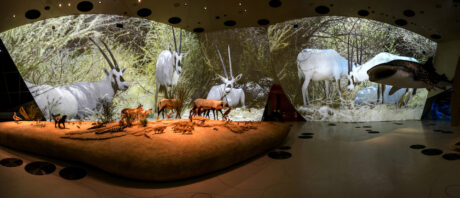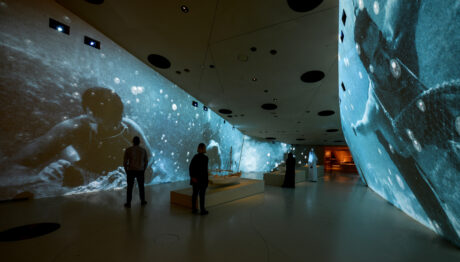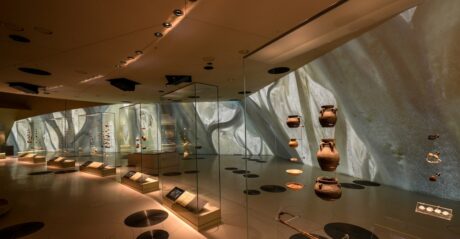
QATAR – Qatar’s remarkable new National Museum launched in spectacular style at the end of March, offering visitors an immersive and experiential journey through the country’s rich history, current identity and aspirations for the future. Much of its 430,000 sq.ft. of indoor space is made up of cinematic display zones, onto which specially-created film content is projected.
More details from RES (www.resgb.com):
The result is the world’s biggest ever permanent video installation. London-based visual technologists, RES, started work on the project in 2014, providing technical consultancy and video media system expertise to The Doha Film Institute (DFI) on technical realisation and pre-visualisation of each film.

As part of its ambitious ‘Art Film’ project, the DFI commissioned nine filmmakers to produce content about Doha’s culture and history, which would be projection mapped in high-resolution onto the museum’s internal surfaces, every day from launch.
The Art Films in each gallery create an immersive audio-visual experience of each subject, bringing to life the narratives of the collections on display in extraordinary, beautiful and innovative ways.
“This is the biggest project RES has ever undertaken,” says Mark Calvert, who managed the project with RES co-founder, Dave Green. “When we first learned about the ambitions for video playback, projection mapping and technical planning, the sheer size of it became apparent. It took all of the skills, experience and technical wizardry we possess to make it happen. This is visual technology on an unprecedented scale.”
Dr Karen Mary Excell is Senior Museum Development Specialist at Qatar Museums, and has been instrumental in the realization of the National Museum of Qatar (NMoQ) project.
“The technology behind each Art Film has been deeply researched to ensure that NMoQ is delivering a ground-breaking, world-class experience,” says Excell. “Mark and Dave’s work has been at the center of this success, with their software, hardware and professional skills applied to the entire project scope of the Art Films’ development and delivery. We are very grateful for their expertise, passion and dedication.”

The video project is on a vast scale. RES estimates that 21,000,000,000 [21 billion] pixels are processed each second, by 172 media servers driving 112 Panasonic 4K projectors. More than one petabyte of media is stored and on playback, the data fed by 50.6km of 3G SDI cabling. Each video requires full motion image resolution as high as 25K by 4K, to cover more than 33,000 sq.ft.
One of the biggest challenges was the sheer quantity of AV equipment, all of which needed to work together in perfect synchronicity. To address this, HIVE Media Control Ltd – a new UK company formed by RES and Harrison Digital Media Inc. – designed a new, bespoke software package called HIVE. HIVE controls and monitors all the Art Films systems site-wide and facilitates simple, intuitive operation of the highly complex system.
HIVE ensures that the operational support and ongoing maintenance is convenient and efficient through a ground-breaking 3D rendered user interface with live video streams rendered into the site geometry. This has overlaid operational UI and all elements of it are available in a web browser application.

From the beginning of the project, RES worked closely with Dean Winkler, founder of New York-based Winkler Consulting Inc. on the technical and creative aspects of the video installation project. Winkler has been working on NMoQ’s Art Films project since 2013 in his capacity as the Senior Engineer, Production and Post Production, for the DFI.
“Pretty much everything RES did was the right solution,” says Winkler, “but perhaps most noteworthy was their ability to take the existing highly complex architectural designs, with little free ceiling space, and figure out how to integrate 112 4K Panasonic projectors to meet the exacting technical specifications of the project.
“The technical quality of their work is beyond reproach. But what really separates Mark and Dave from everyone else is their ‘can do’ attitude to solving problems, which in this case was more like ‘whatever it takes, we’ll solve it’. Mark and Dave provided by far the best solution both in image quality and creative support for the project.”
New York-based Nice Shoes Creative Studio worked with RES on an integrated film design solution on the project. CIO of Nice Shoes is Robert Keske: “During our collaboration, Dave and Mark were keen to help find innovative solutions to allow creative editorial and color grading of every film we jointly worked together. RES offers professionalism, attention to detail and a basic want to collaborate with others to build unique, top-quality pieces. They are one of the cornerstones of this project, delivering the highest levels of solution quality.”

RES approached Gareth Day, Group Manager at Panasonic Visual Systems (UK), to realize the extensive projection requirements.
“Working alongside Mark and Dave, we began testing equipment that we believed could address the technical challenges faced in positioning projection equipment to provide the large scale, high quality images required,” explains Day. “This project has been a hugely significant for Panasonic, being the largest single rollout of the PT-RQ13 4k+ projector globally. The success of the RES and Panasonic equipment has been the ability to reproduce images of outstanding quality from the shortest viewing distances, and with the flexibility to position the projectors as unobtrusively as possible making this an incredibly exciting project in which to be involved. Panasonic has been delighted to be involved in a project of this scale.”
Designed by architect Jean Nouvel, the National Museum of Qatar is located on a 1.5 million sq.ft site surrounding the existing Fariq Al Salatah Palace, which had served as a museum of heritage since 1975. The building consists of a ring of interlocking display zones, encircling a large central courtyard area. Its design is inspired by the famous phenomenon of the ‘desert rose’: crystalline forms, like miniature architectural events, that emerge from the ground through the work of wind, salt water, and sand.

Image Credit: © Antonio Pagano / RES


